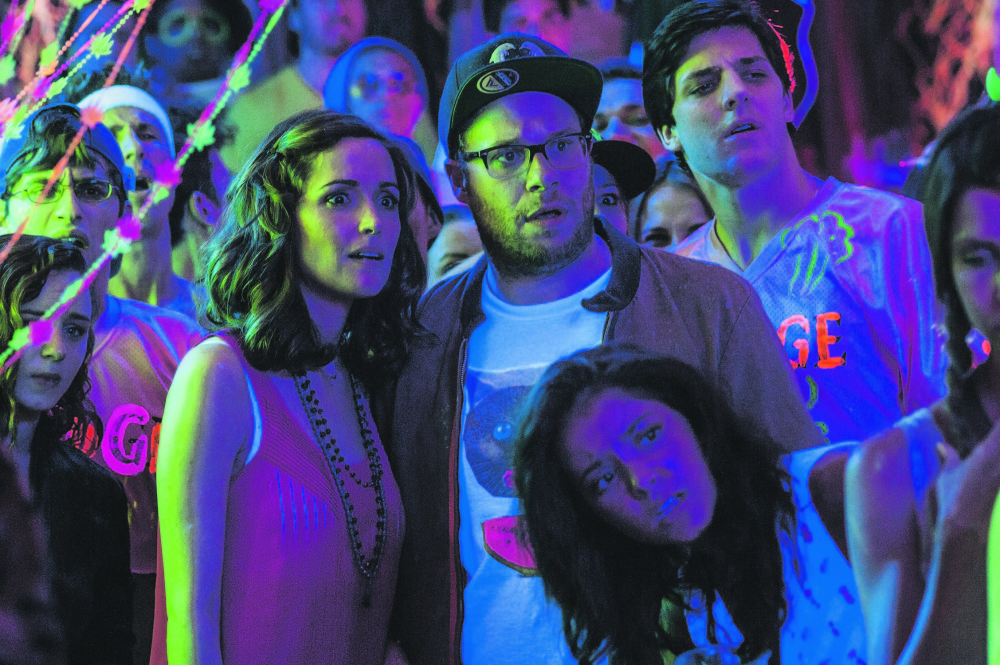LOS ANGELES — How to throw a great party is a question that has kept Martha Stewart in business for decades. How to throw a great party scene, well, that takes expertise too. Director Nick Stoller, who throws the many ragers in the new comedy “Neighbors,” gave his behind-the-camera hosting duties a lot of thought.
“Party scenes are an overlooked cinematic trope,” said Stoller, who also directed 2010’s bash-heavy “Get Him to the Greek.” “The goal was to make it feel really dynamic, like you’re there, and you’re drunk.”
In “Neighbors,” due in theaters Friday, the Delta Psi Beta fraternity moves into the house next door to new parents Mac and Kelly (Seth Rogen and Rose Byrne). Former partyers confronting their own waning coolness, the couple at first try to get along with preening frat president Teddy (Zac Efron) and his fraternity brothers (Dave Franco, Christopher Mintz-Plasse). But in the script by first-time screenwriters Andrew J. Cohen and Brendan O’Brien, one too many sleepless nights leads to a war between households – and an escalation in the size and creativity of the frat’s fetes.
At one point, Delta Psi Beta throws a Robert De Niro party, in which members dress up as different characters from the actor’s films. (“Dave Franco clearly spent the entire weekend before we shot that scene practicing his ‘Meet the Fockers’ De Niro,” Stoller said. “He actually hurt his face”). There are also fireworks, fights and moments of debauchery so raunchy that when perennial big screen man-child Rogen declares, “Ew! So immature!,” he’s utterly convincing. (That Rogen and Efron both have off-screen images as gentlemen who enjoy their downtime is not likely to be lost on the audience.)
“Neighbors” is just the latest in a long tradition of movies that have sought to create the woozy sensations of decadence and disorientation experienced by partygoers.
In what is arguably the most puerile film selected for preservation by the Library of Congress, 1978’s “Animal House,” director John Landis created a party atmosphere so convincing and infectious, he single-handedly revived the toga tradition. In the ‘70s-set film “Dazed and Confused” (1993), Richard Linklater captured the quintessential high school experience of driving around looking for a party – and gave us Matthew McConaughey’s first display of slacker-partyer charm and the first of many “alright, alright, alrights.”
Sometimes, a party scene is meant to portray a world you’re not sure you want to be a part of, as in “Annie Hall,” when Woody Allen’s Alvy Singer reluctantly ventures to a party at the Los Angeles home of Paul Simon’s character, where he finds himself surrounded by vapid boobs like a young Jeff Goldblum, frantically calling his guru because he forgot his mantra. Sometimes, a scene portrays a party lifestyle that seems too dangerous, as in Stanley Kubrick’s quasi religious orgy in “Eyes Wide Shut” (1999). And sometimes it shows an entire culture taking a dive, as in Paul Thomas Anderson’s long tracking shot at a pool party in “Boogie Nights.”
Stoller said he was visually inspired by the 2009 French drama “Enter the Void,” directed by Gaspar Noe, which is shot among the neon-lighted nightclubs of Tokyo. Stoller and director of photography Brandon Trost watched the movie for lighting ideas, one of the key elements of creating a party scene’s mood, the director said. On “Neighbors,” they relied on black lights, lasers and strobes to keep the illumination constantly changing on the actors’ faces.
Stoller, 38, said he did have life experience to draw upon as well; although he was never a member of a fraternity, he was on the staff of the undergraduate humor publication the Harvard Lampoon, known for its blowouts. “I certainly enjoyed myself,” he said of his collegiate partying career. “But you get older. The movie is quite autobiographical.”
Together with production designer Julie Berghoff, Stoller worked to create the look of a house wholly devoted to excess. Drawing upon ideas from campus visits and Google Image searches, they placed multiple sofas on the porch of the West Adams home that served as Delta Psi’s pad, a pingpong table on the lawn and, in seemingly every room, a big-screen TV blasting a video game.
“We talked a lot about the aesthetic of the frat,” Stoller said. “We wanted it to be authentically disgusting.”
To create the feeling of being lost in the crowd, they placed cameras low. “When you can’t see over people’s heads, that makes the party feel more epic,” Stoller said. They also handed out small cameras and iPhones to extras in the party scenes, and editor Zene Baker cut together the footage to evoke a frenetic feeling.
Among his cast, Stoller relied on actors who excel at pretending to be drunk – a surprisingly hard thing to do. “You basically have to be trying to be sober,” Stoller said. “It fails when people are slurring their words.”
In the movie’s sound mix, Stoller turned the music, including a song by rapper Flo Rida, up so loud that it blots out the actors’ dialogue, re-creating the feeling of cupping your ear to communicate at a bash.
He also used material that made the camera strobe, to create the illusion that the audience also is stumbling through the crowd, searching for the exit.
“Parties are really fun until they’re not,” Stoller said. “And then they’re the worst thing ever.”
Send questions/comments to the editors.



